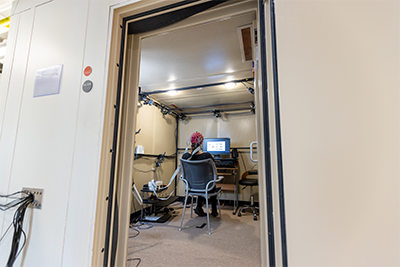The brains of children with autism may not always 'see' body language
July 27, 2022

|
| Alt text: Research participant sits in EEG booth, wearing red and black cap while facing a computer screen. |
AUCD's network of Intellectual and Developmental Disability Research Centers (IDDRCs) consists of 16 Centers. Fifteen Centers currently receive funding from the Eunice Kennedy Shriver National Institute for Child Health and Human Development (NICHD). IDDRCs contribute to the development and implementation of evidence-based practices by evaluating the effectiveness of biological, biochemical, and behavioral interventions; developing assistive technologies; and advancing prenatal diagnosis and newborn screening.
Noticing and understanding what it means when a person leans into a conversation or takes a step back and crosses their arms is a vital part of human communication. Researchers at the Del Monte Institute for Neuroscience at the University of Rochester have found that children with autism spectrum disorder may not always process body movements effectively, especially if they are distracted by something else.
“Being able to read and respond to someone’s body language is important in our daily interactions with others,” said Emily Knight, M.D., Ph.D., clinical and postdoctoral fellow in Pediatrics and Neuroscience, is the first author of the study recently published in Molecular Autism. “Our findings suggest that when children with autism are distracted by something else, their brains process the movements of another person differently than their peers.”
Key differences in brain processes
Using electroencephalogram (EEG), researchers recorded the brain waves of children with and without autism as they watched videos of moving dots that were arranged to look like a person. In these videos the dots moved to represent actions such as running, kicking, or jumping, and at times were turned in different directions or jumbled to no longer move like a person. The six to 16 years olds were asked to either focus on the color of the dots or to focus on whether the dots moved like a person. Researchers found the brainwaves of children with autism did not process when the dots moved like a person if they were focused on the dot color.
“If their brain is processing body movements less they might have a harder time understanding other people, and need to pay extra attention to body language in order to see it,” said Knight. “Knowing this can help guide new ways to support people with autism.”
“This is more evidence of how the brain of someone with autism is processing the world around them,” said John Foxe, Ph.D., led author of the study. “This research is a vital step in creating a more inclusive space for people with autism by giving a glimpse of how their brain processes an unspoken part of communication.”
Additional authors include Ed Freedman, Ph.D., from the University of Rochester Medical Center, John Butler, Ph.D., Aaron Krakowski, and Sophie Molholm, Ph.D., of Einstein College of Medicine. This research was supported by the National Institute of Mental Health and the University of Rochester Intellectual and Developmental Disability Research Center (UR-IDDRC) and the Rose F. Kennedy Intellectual and Developmental Disabilities Research Center (RFK-IDDRC).
# # #







